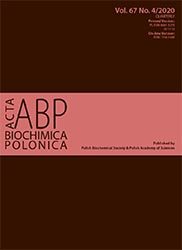The levels of sICAM-1, sELAM-1, TNFα and sTNFR1 proteins in patients with colorectal adenocarcinoma in tumor and corresponding normal mucosa
Abstract
Colorectal cancer is a common malign disease of the gastrointestinal tract. The cancer survival rate depends on the stage of the disease at detection time. It is well known that several molecular mechanisms are involved in cancer and some molecules might affect or modulate cancerogenesis. The aim of the study was to assess the levels of sICAM-1, sELAM-1, TNFα and sTNFR1 protein in tumor and corresponding normal mucosa in a group of patients with colorectal adenocarcinoma and also associations of these parameters with demographic and clinical profiles of the patients. Tissue specimens were obtained during resection of neoplastic lesions. Protein levels were assayed in tissue homogenates by ELISA. The protein level of sICAM-1 in tumor was significantly increased in comparison to the corresponding normal mucosa (80.06 ng/mg vs 69.53 ng/mg, p=0.02). Furthermore, a significant positive correlation between sICAM-1 and sTNFR1 proteins levels in tumor (rs=0.58, p<0.001) and in corresponding normal mucosa (rs=0.48, p<0.001) was found. Also, significant correlations in corresponding normal mucosa were found between sELAM-1 and sICAM-1 (rs=0.58, p<0.001) and between sTNFR1 and sELAM-1 (rs=0.57, p<0.001). Significantly higher level of sTNFR1 in corresponding normal mucosa samples of patients with distant metastases was observed (p=0.04). Obtained results suggest that sICAM-1 protein could be considered as colorectal cancer marker. Furthermore, sTNFR1 also has the potential to become a good prognostic marker used during monitoring of the patients. Nevertheless, a further study in this area to confirm this correlation is required.
Acta Biochimica Polonica is an OpenAccess quarterly and publishes four issues a year. All contents are distributed under the Creative Commons Attribution-ShareAlike 4.0 International (CC BY 4.0) license. Everybody may use the content following terms: Attribution — You must give appropriate credit, provide a link to the license, and indicate if changes were made. You may do so in any reasonable manner, but not in any way that suggests the licensor endorses you or your use.
Copyright for all published papers © stays with the authors.
Copyright for the journal: © Polish Biochemical Society.


